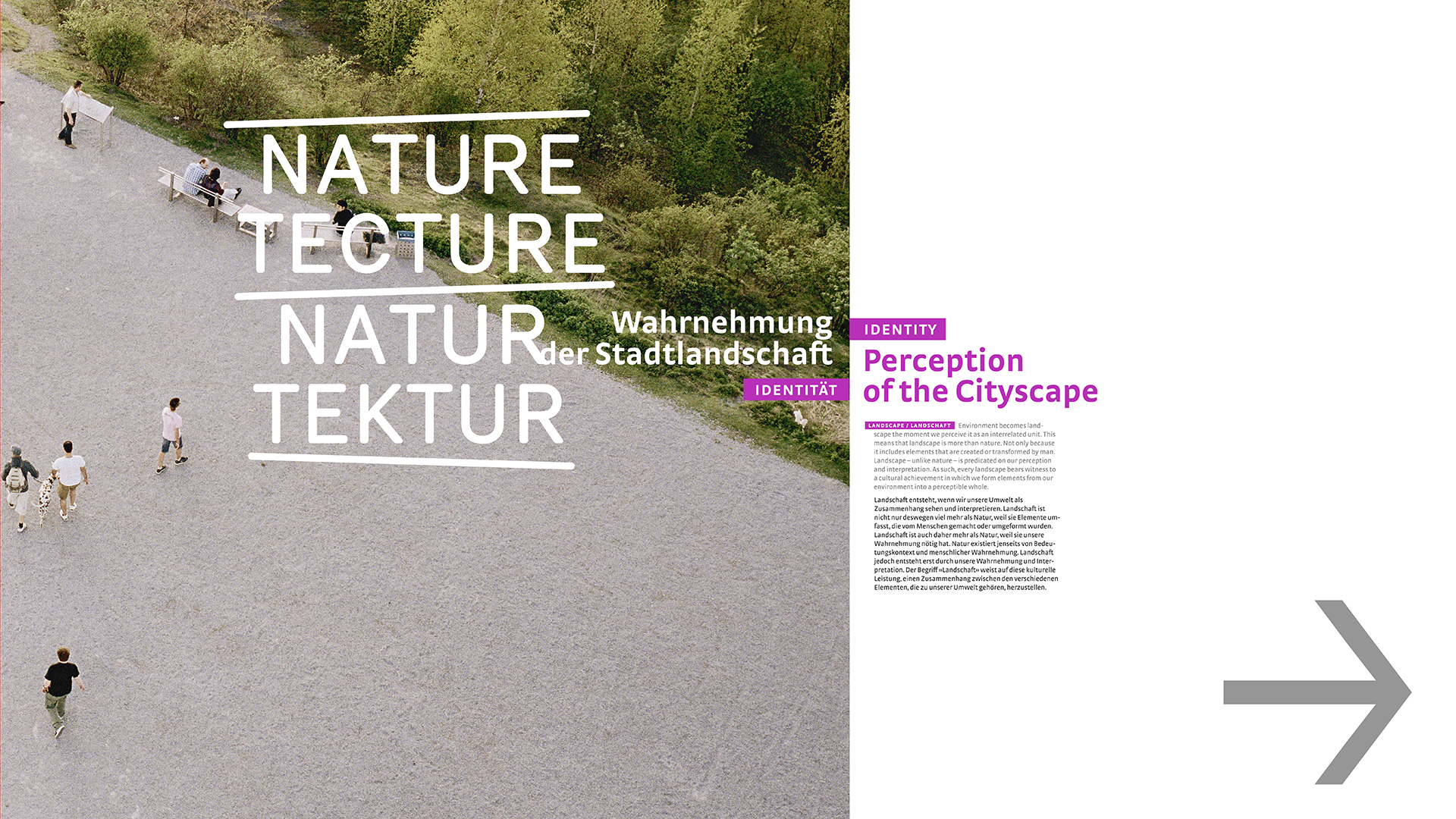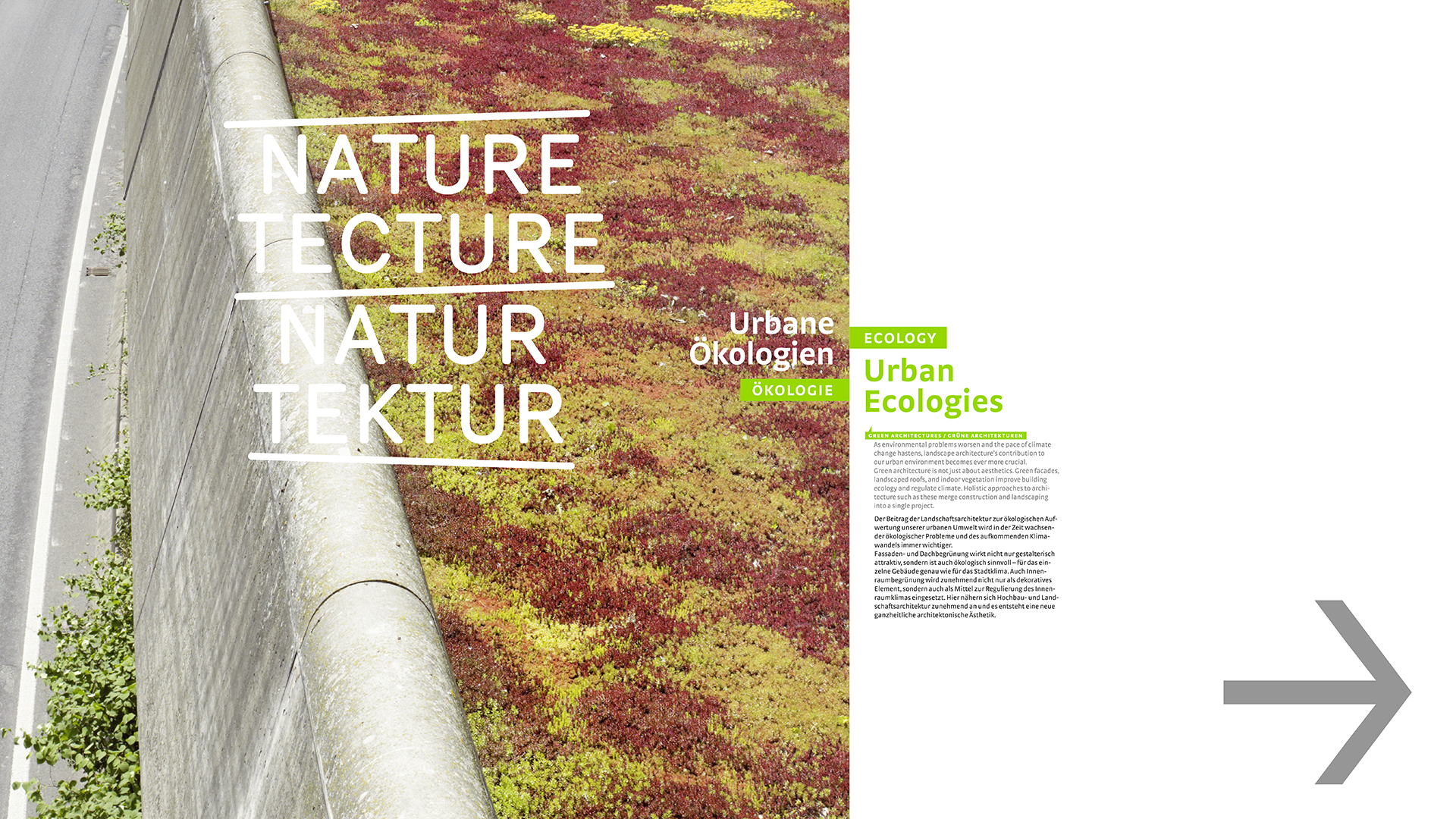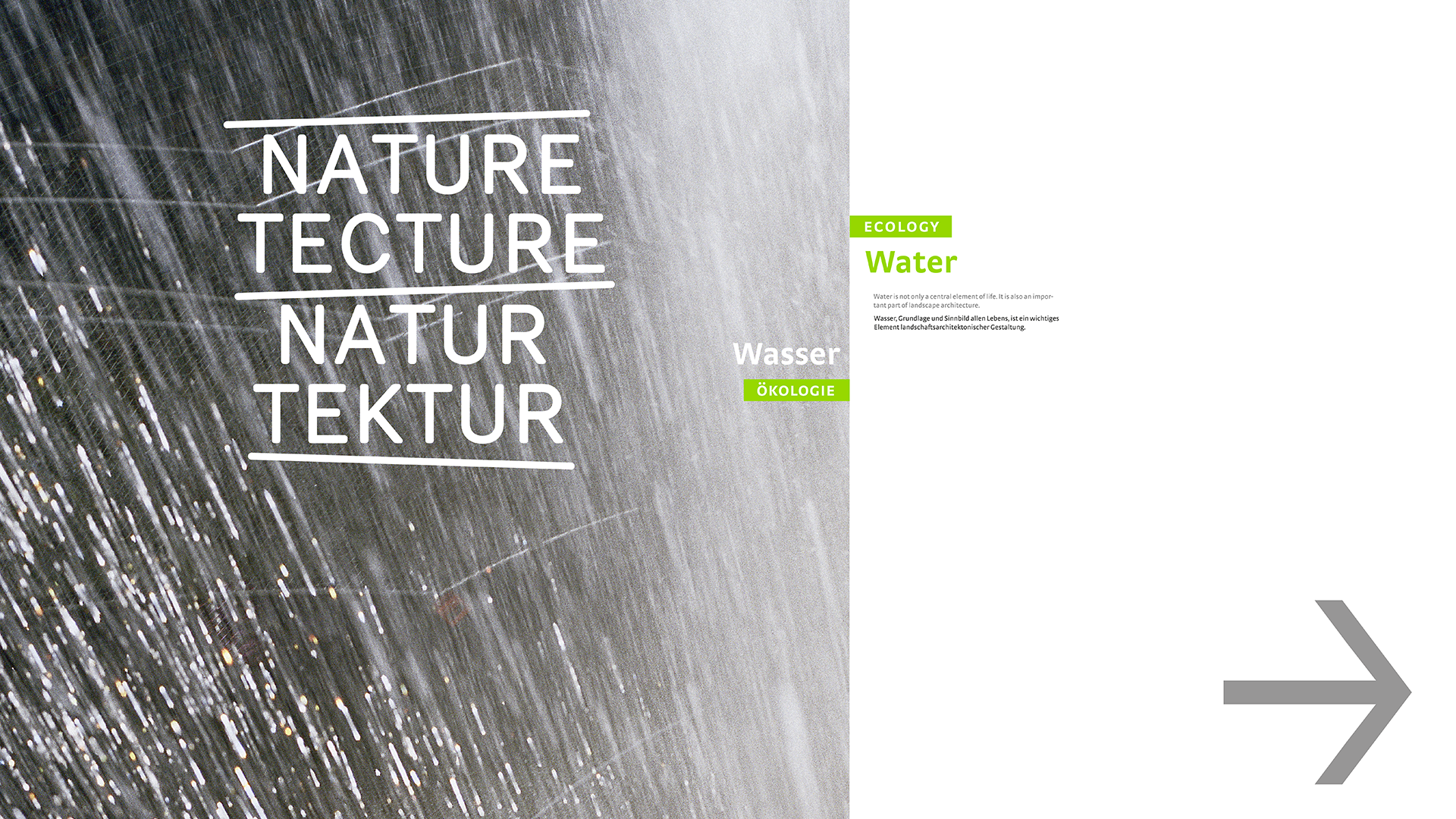NatureTecture presents the fields of landscape architecture in all their breadth and relevance.
NatureTecture focuses on those fields of work that will become increasingly important internationally for the design of our living environments and formulates relevant questions for the future.
NatureTecture is dedicated to the tasks and instruments of qualifying landscape in the post-industrial age.
Concept NatureTecture @ Chamber of Architects, North Rhine-Westphalia, Germany, 1 September 2009

→ logo by NODE Oslo Berlin
The exhibition is based on landscape architectural expertise from North Rhine-Westphalia and refers to examples of landscape architecture from NRW.
The international travelling exhibition on the fields of work of landscape architecture is organized by the Chamber of Architects of North Rhine-Westphalia with the support of the Ministry of Building and Transport of the State of North Rhine-Westphalia.
Exhibition NatureTecture @ House of Architects, Düsseldorf, Germany, 11 February-17 March 2010
Exhibition NatureTecture @ Representation of the State of North Rhine-Westphalia to the European Union, Brussels, Belgium, 9 June-12 July 2010
Exhibition NatureTecture @ Korea & China & Germany International Architecture Exhibition in Jeonju, Republic of Korea, 1-4 September 2010
Exhibition NatureTecture @ 2010 Daejeon Architecture Culture Festival, Republic of Korea, 14-19 October 2010
Exhibition NatureTecture @ Architecture and Urbanism Fair Gwangju, Republic of Korea, 3-7 November 2010
Exhibition NatureTecture @ Turkish Chamber of Architects of the Metropolis of Istanbul, Turkey, 26 November-10 December 2010
Exhibition NatureTecture @ 20th Anniversary of German Reunification, Busan, Republic of Korea, 8-14 December 2010
Exhibition NatureTecture @ Seoul National University, Republic of Korea, 2-9 December 2011
Exhibition NatureTecture @ Representation of the State of North Rhine-Westphalia to the German Federation, Berlin, 26 March-18 April 2012
Exhibition NatureTecture @ Floriade-Pavilion of the State of North Rhine-Westphalia, Venlo, The Netherlands, 16-22 April 2012
Can landscape drive urban development?
Three projects from North Rhine-Westphalia show the importance of parks and open spaces in pushing urban development and the role of landscape architecture in shaping our environment. The projects differ from one another in scope and origin:
· the promenade of the Königsallee in Düsseldorf, dating from absolutist times
· the Cologne »greenbelt« public park system, dating from the start of the city’s municipal planning
· the green corridors in the Ruhr, dating from the beginning of regional planning in the area
How do we give landscape back its ground?
Industrial landscapes the world over are being shut down and abandoned – and they are there for the taking. The task of creating a post-industrial landscape from these spaces is one of the important global challenges today.
In the last decades, landscape architecture has reclaimed many obsolete manufacturing grounds, harbors and industrialized agricultural lands and opened them to the public.

→ foto by Julian Röder
How to create designed landscapes from the utility lands of today?
The development of regenerative energies is crucial to a sustainable environmental policy. A key part of climate protection and sustainability is the use of traditional agricultural lands for energy production, and their affect on the landscape of regions where energy is harvested.
Exploring utility lands and developing their potential as future designed landscapes provide landscape architects with new and important fields of work – from integrating utility landscapes into the designed landscapes that have formed around them to developing new landscape visions.

→ foto by Julian Röder
How does art interpret and form the landscape?
Art that takes landscape as its subject reflects our changing relation to nature.
The artistic reshaping and reinterpretation of landscape is closely tied to the design of our natural environment and open spaces.

→ foto by Julian Röder
How does landscape support our regional identity?
»REGIONALE« is the name of North Rhine-Westphalia’s program to promote regional identity and development. »REGIONALE« includes grants for projects throughout the federal state.
Regions who want to apply must submit a concept, and winners receive priority funding for their projects. »REGIONALE« also sponsors programs that strengthen regional identity by means of landscape architecture.
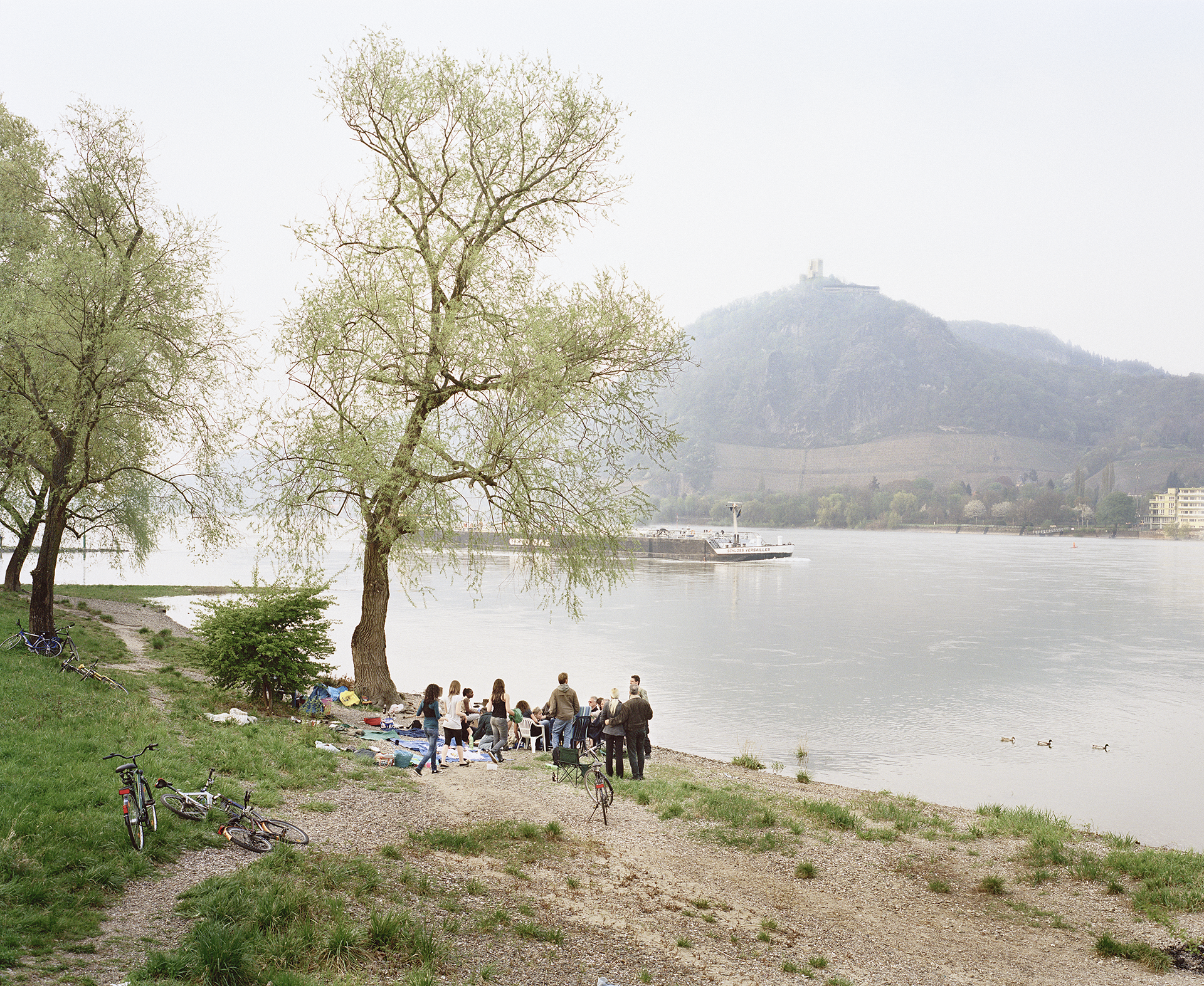
→ foto by Julian Röder
Do we even perceive our cityscapes?
Environment becomes landscape the moment we perceive it as an interrelated unit. This means that landscape is more than nature. Not only because it includes elements that are created or transformed by man. Landscape – unlike nature – is predicated on our perception and interpretation.
As such, every landscape bears witness to a cultural achievement in which we form elements from our environment into a perceptible whole.

→ foto by Julian Röder
Green wrapping?
As environmental problems worsen and the pace of climate change hastens, landscape architecture’s contribution to our urban environment becomes ever more crucial.
Green architecture is not just about aesthetics. Green facades, landscaped roofs, and indoor vegetation improve building ecology and regulate climate. Holistic approaches to architecture such as these merge construction and landscaping into a single project.
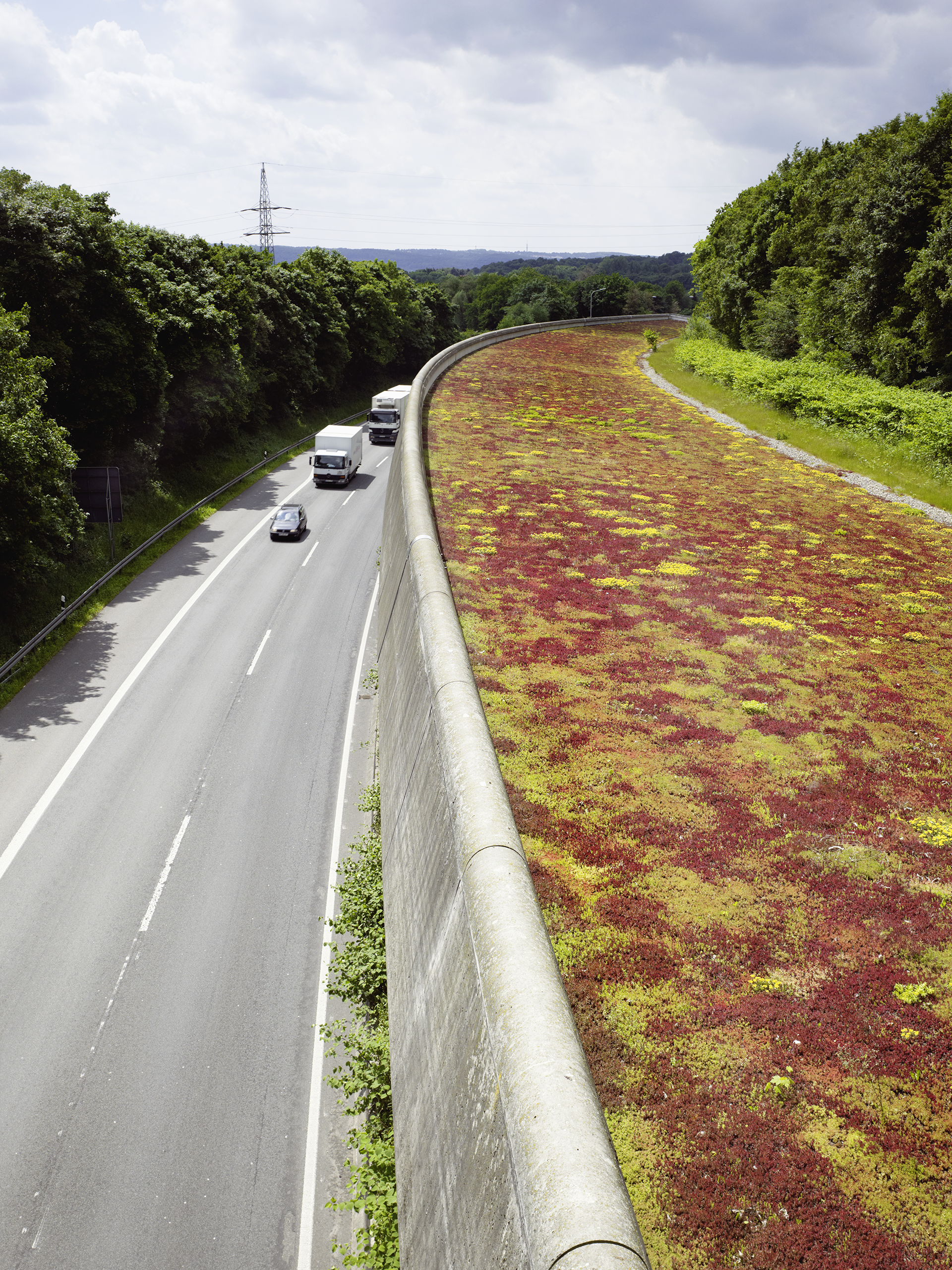
→ foto by Julian Röder
How do we design water?
Water is not only a central element of life. It is also an important part of landscape architecture.

→ foto by Julian Röder
What are nature’s life strategies?
Biodiversity comprises diversity within species and between species as well as the variety of ecosystems. Biodiversity is one of nature’s vital strategies.
The greater diversity of animal and plant species the better the chances of their successful adaptation and reproduction.
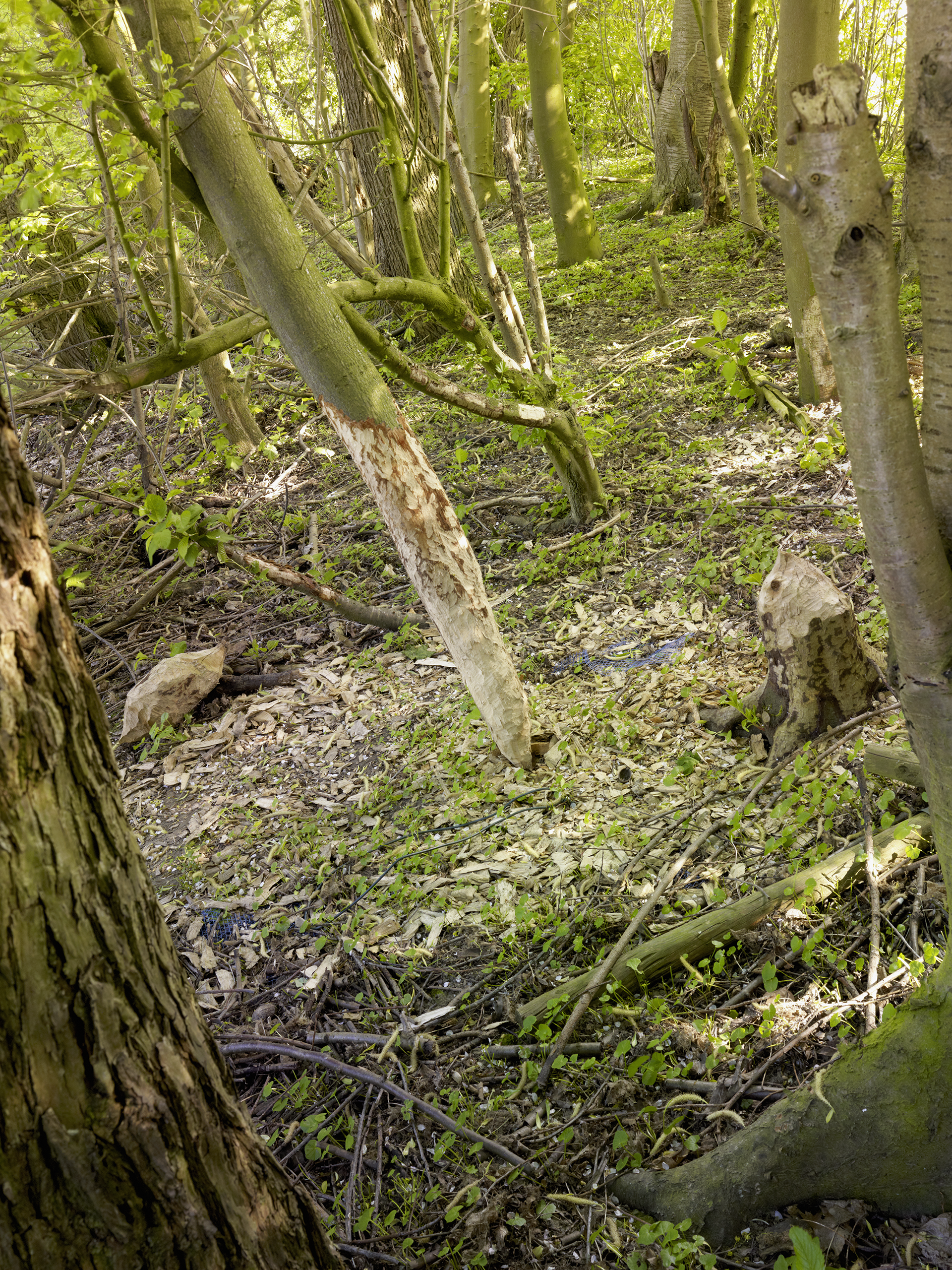
→ foto by Julian Röder
Does the design of open space support social cohesion?
One of the important tasks of landscape architecture is the design of public urban space – space for social interaction. By forming these communal spaces, landscape architecture strengthens the cohesion of our society.
The typologies of inner-city public spaces include the open areas around residential buildings, urban squares, and pedestrian zones.
These dense urban public spaces are a phenomenon typical of the European city.
Alongside these traditional inner-city public spaces new forms of public space are arising in the urban peripheries. These new suburban public spaces are often attached to mobility spaces, as in the case of parking lots used as meeting points.

→ foto by Julian Röder
Where do we play?
Children are spending more and more time indoors in front of the television and the computer screen. This hampers the development of their social, motor, and cognitive abilities, and does nothing to foster a creative approach to their physical environment and, hence, to themselves.
To counteract this trend, children need more outdoors spaces where they can play and explore their physical environments. Landscape architecture is able to create such spaces – for the child and adolescent as well as for the adult homo ludens.

→ foto by Julian Röder
New spaces of mourning?
The way we think about cemeteries is changing. Cemeteries are no longer places exclusively for grief and remembrance; they are also places of nature in urban environments. One example: some beekeepers now use cemeteries as foraging areas for their hives.
In our individualized and changing society, traditional codes and rituals of mourning have lost their meaning. But we have yet to establish new forms and spaces of mourning in their place. Only recently have people begun imagining alternative ways to mourn.
One source of change to how we mourn is the influx of traditions brought by immigrants. In particular, their cultures of mourning are shaping the design of cemeteries in their function as eternal resting places.
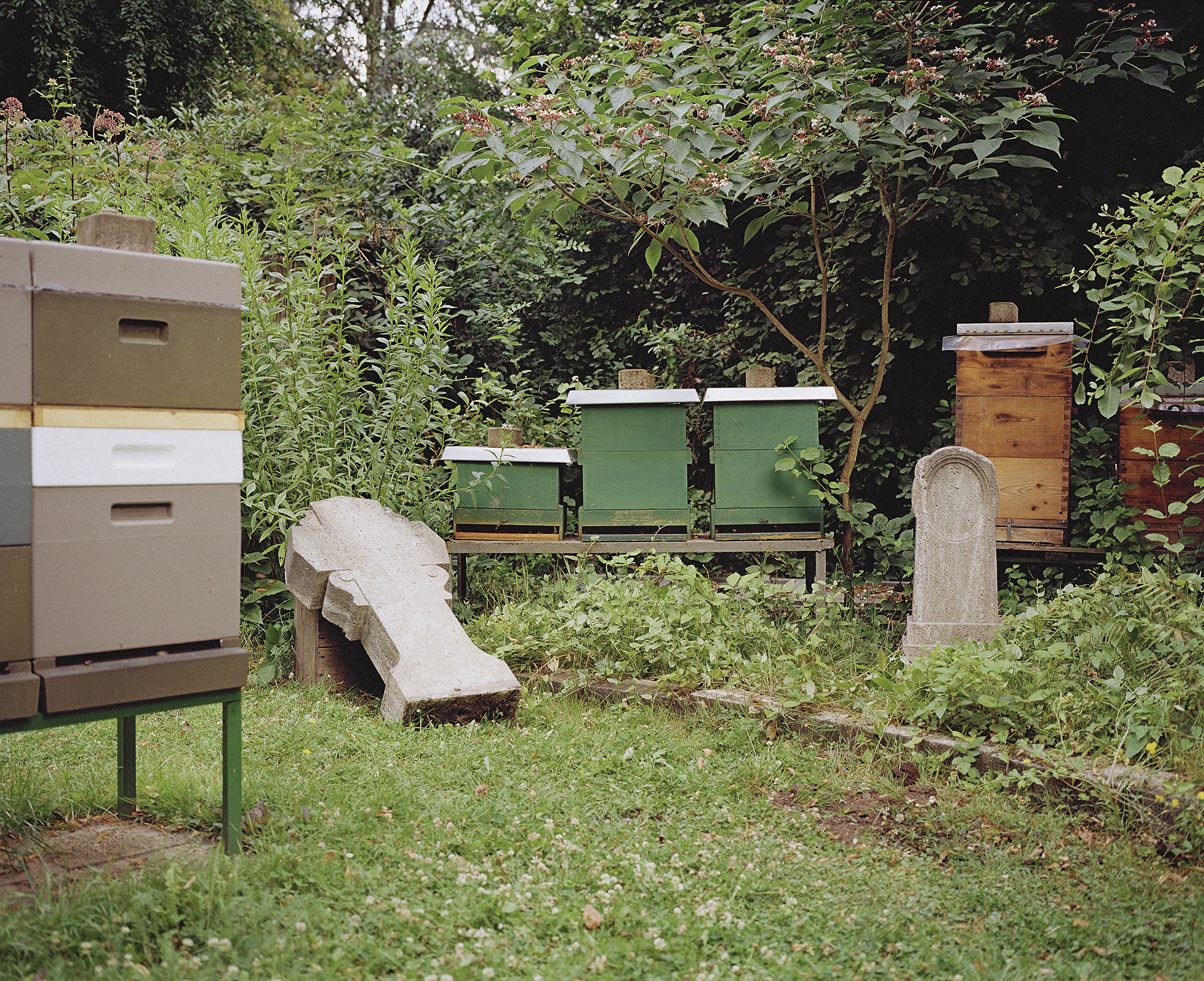
→ foto by Julian Röder
How do gardens bring society together?
Landscape architecture is not just about classical planning and design. It is also about bringing society together. Landscape architects routinely work with engaged citizens to realize public projects such as community parks and allotment gardens. What was once a parking lot cum illegal waste dump is now a garden idyll.
In 1995 eight committed families from Düsseldorf came together to found »Neue Lohe,« an association devoted to creating a community garden in the former no-man’s land. The garden they built contains 8 plots uninterrupted by fences arranged around a common space. The garden’s vegetation offers a contrast to the office building that borders it to the north.
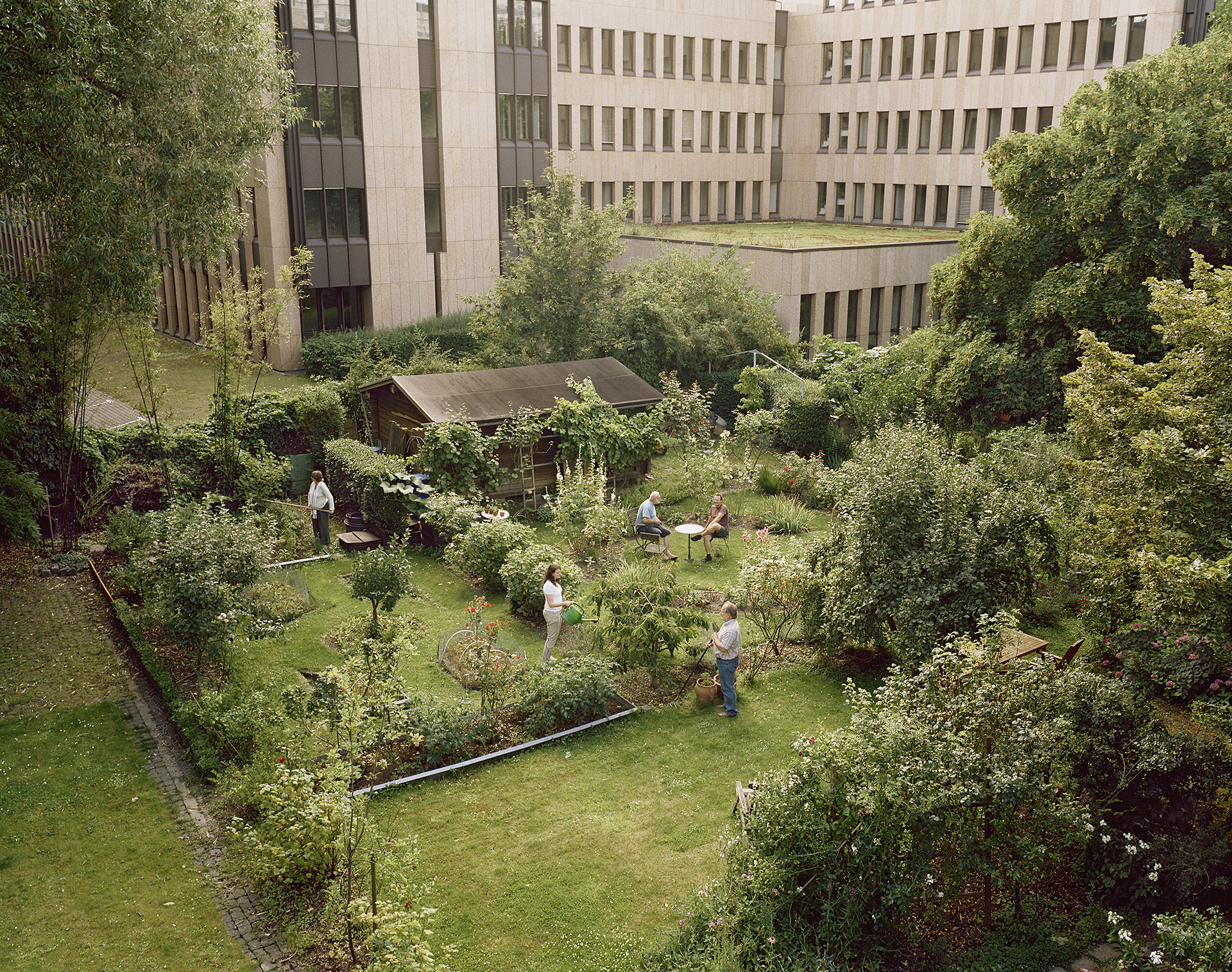
→ foto by Julian Röder
Landscape
Architecture
as
Dynamic
Field
The international travelling exhibition presents a broad spectrum of themes in landscape architecture. It focuses on areas of the profession poised to gain international importance, illustrating the tasks and techniques of landscape design in the post-industrial age.
The exhibition provides a wealth of knowledge about landscape architecture and features examples from Germany’s North Rhine-Westphalia.
An international travelling exhibition on the working fields of landscape architecture by the Chamber of Architects of North Rhine-Westphalia with the support of the Ministry for Building and Transport of the State of North Rhine-Westphalia.
Prof. Elizabeth Sikiaridi & Prof. Frans Vogelaar, Hybrid Space Lab
Julian Röder & Johannes Schwartz
Prof. Wim Westerveld, Fides Sigeneger, Tilmann Hielscher
Logo: NODE Berlin Oslo
Land schafft Stadt / Influent Urban Landscapes
Recycling Landschaften / Recycling Landscapes
Energie Landschaften / Energy Landscapes
Kunst & Landschaft / Art & Landscape
Regionale Landschaften / Regional Landscapes
Wahrnehmung der Stadtlandschaft /
Perception of the Cityscape
Urbane Ökologie / Urban Ecology
Wasser / Water
Biodiversität / Biodiversity
Spiel und Freizeit / Play and Leisure
Lebendige Friedhöfe / Living Cemeteries
Gemeinschaftsgärten / Community gardens
This project would not have been possible without the commitment and help of numerous players from North Rhine-Westphalia. We would like to thank them all once again for their support, including those whose material could not be shown within the limited scope of this exhibition!
In addition to the many landscape architecture, urban planning and architecture firms that provided us with their material, we would like to express our special thanks to the following people: Anatol (Insel Hombroich), Dr. Joachim Bauer (Leiter der Planungsabteilung im Amt für Landschaftspflege und Grünflächen der Stadt Köln), Oliver Bremm (Tourismus Siebengebirge GmbH), Ingo Bünning (Verein »Lebendiger Niederrhein« e.V.), Familie Closterman (Neuhollandshof, Wesel-Bislich), Burkhard Damm (Stiftung Insel Hombroich), Frau Gärtner (RVR), Arnd Gottschalk (EuRegionale 2008 Agentur GmbH), Jens Grisar (Regionale 2010 Agentur GmbH), Lucas de Groot (FontFabrik), Ira Hellental, Heike Herold (Leiterin OWL Kulturbüro), Ursula Hilden (Hombroich), Markus Hofmeier (Interone Worldwide GmbH), Katja Holzmüller (Umweltamt der Stadt Düsseldorf), Jürgen Hommes (Bezirksregierung Düsseldorf), Frau Jenning (Deutsche Rentenversicherung Rheinland), Sabine Junker (Europäisches Haus der Stadtkultur e.V.), Kerstin von Klein, Dr. Bernhard Korte, Eckart Kröck (Leiter des Planungsamtes der Stadt Bochum), Gudrun Lethmate (RVR), Dafni Lianantonaki, Peter Liedke, Imkerei Luchten in Düsseldorf, Ulla Lux (Leiterin des Kulturamtes der Landeshauptstadt Düsseldorf), Paola Malavassi (Museum Ludwig), Rolf Martin (JAS Jugend Architektur Stadt e.V.), Dr. Matthias Meusch (Landesarchiv NRW Abteilung Rheinland Standort Düsseldorf), Julia Mikolaschek (AKNW), Dr. Reimar Molitor (Regionale 2010 Agentur GmbH), Horst Neuendorf (Deutscher Alpen Verein – Sektion Duisburg-Nord), Annette Nothnagel (Bergische Entwicklungsagentur GmbH), die Oberbilker Stadtgärtner, Dr. Martina Oldengott (Emschergenossenschaft), Ingelore Pohl (EGHN), Gerhard Reisinger (Rheinische Friedrich-Wilhelms-Universität Bonn), Angelika Schallenberg (Kulturabteilung der Stadt Pulheim), Ulrike Scheffler-Rother (»Neue Lohe« e.V.), Elmar Scheuren (Leiter des Siebengebirgsmuseum der Stadt Königswinter), Wilfried Schulze (NaturForum Bislicher Insel und Regionalverband Ruhr-Grün), Ralf Schumacher (Emschergenossenschaft), Jens Spanjer (Stiftung Schloss Dyck), Klaus Spitzer (Ökotop Heerdt), Brigitte Suttmann (Stadtplanungsamt der Stadt Herten), Andrea Trudewind (Stadtarchiv Landeshauptstadt Düsseldorf), Gabriele Uerscheln (Direktorin des Museums für Europäische Gartenkunst und des Corps de Logis und wissenschaftlicher Vorstand der Stiftung Schloss und Park Benrath), Corinne Valentin (Stiftung Zollverein Schacht XII), Henk Vos (EuRegionale 2008 Agentur GmbH), Alexander Ware (Archimation), Silke Wiebrock (Garten-, Friedhofs- und Forstamt der Stadt Düsseldorf), Monika Witte, Barbara Wolf (Planungsamt der Stadt Düsseldorf), Friedrich Wolters (Wolters & Partner).
The contents of the exhibition have been compiled with the greatest possible care. Many people have supported us with information and material. It was not always possible to check this information from external sources. We would like to apologise in advance for any errors that are unavoidable in such an extensive project. The curators and editorial team can therefore accept no liability for the accuracy, completeness and currency of the content provided.
1.1.1: © Julian Roeder / OSTKREUZ-Agentur der Fotografe
1.1.3: Landesarchiv NRW – Abteilung Rheinland – Karten Nr. 3175
1.1.4: Landesarchiv NRW – Abteilung Rheinland – RW 0229 Nr. 22740
1.1.5: Stadtarchiv Landeshauptstadt Düsseldorf
1.1.6: Lisa Albrecht, 2009, © Hybrid Space Lab
1.1.7: Stadtarchiv Landeshauptstadt Düsseldorf
1.1.8: Lisa Albrecht, 2009, © Hybrid Space Lab
1.1.9: F. Schumacher. Entwicklungsfragen einer Groszstadt. Köln 1923. In: Meynen, H.: Die Kölner Grünanlagen. 1979, Düsseldorf, Abb. 189, o.S.
1.1.10: Amt für Landschaftspflege und Grünflächen der Stadt Köln
1.1.11: Werkgemeinschaft Freiraum Nürnberg, Landschaftsarchitekten
1.1.13: Lisa Albrecht, 2009, © Hybrid Space Lab
1.1.14: und 1.1.15: Siedlungsverband Ruhrkohlenbezirk 1920–70, Nr. 29 der Schriftenreihe Siedlungsverband Ruhrkohlenbezirk, Essen 1970, Hrsg. Siedlungsverband Ruhrkohlenbezirk, Essen
1.1.16: © Thomas Wolf, 2005
1.1.17: Masterplan Emscher-Zukunft, 2006, Emschergenossenschaft, Essen
1.2.1: © Johannes Schwartz, 2009
1.2.2: und 1.2.3: Birgit Kather, 2009, © Hybrid Space Lab
1.2.4: Archiv der Stadt Bochum; zur Verfügung gestellt durch skt umbaukultur
1.2.5: © Christian Meisert; zur Verfügung gestellt durch herbstreit Landschaftsarchitekten
1.2.6: zur Verfügung gestellt durch das Presseamt der Stadt Bochum
1.2.7: Presseamt der Stadt Bochum; zur Verfügung gestellt durch skt umbaukultur
1.2.8: Birgit Kather, 2009, © Hybrid Space Lab
1.2.9: © Julian Roeder / OSTKREUZ-Agentur der Fotografen
1.2.10: Latz + Partner Landschaftsarchitekten
1.2.11: Atelier 17 Christa Panick; zur Verfügung gestellt durch Latz + Partner Landschaftsarchitekten
1.2.12: Michael Latz
1.2.13: Thomas Mayer – www.thomasmayerarchive.de; zur Verfügung gestellt von Agence Ter
1.2.14: Planergruppe GmbH Oberhausen
1.2.15: bis 1.2.18: Birgit Kather, 2009, © Hybrid Space Lab
1.2.19: Dr. Bernhard Korte
1.2.20: und 1.2.21: © Landesvermessungsamt Nordrhein-Westfalen
1.3.1 bis 1.3.3: © Julian Roeder / OSTKREUZ-Agentur der Fotografen
1.3.4: und 1.3.5: Marcel Soppa, © Deutsches Zentrum für Luft- und Raumfahrt
1.3.6: Michael Latz
1.3.7: Karl Pauly Luftbildfotografie, © RMP Stephan Lenzen Landschaftsarchitekten
1.3.8: bis 1.3.11: zur Verfügung gestellt durch Stiftung Schloss Dyck
2.1.1: © Johannes Schwartz, 2009
2.1.2: © Julian Roeder / OSTKREUZ-Agentur der Fotografen
2.1.3: H.-J. van der Bossche, 2005 © Flemish Heritage Institute, Brussels; zur Verfügung gestellt von Stiftung Schloss Dyck Zentrum für Gartenkunst und Landschaftskultur
2.1.4: Günther Kallen / Museum für Europäische Gartenkunst Schloss Benrath
2.1.5: und 2.1.6: J. Gregori / Rheinisches Amt für Denkmalpflege / LVR; zur Verfügung gestellt von Stiftung Schloss Dyck Zentrum für Gartenkunst und Landschaftskultur
2.1.7: bis 2.1.9: Kalle / LWL / WALB; zur Verfügung gestellt von Stiftung Schloss Dyck Zentrum für Gartenkunst und Landschaftskultur
2.1.10: Rüdiger Block, Hürth; zur Verfügung gestellt von Stiftung Schloss Dyck Zentrum für Gartenkunst und Landschaftskultur
2.1.11: Pridik + Freese; zur Verfügung gestellt von Stiftung Schloss Dyck Zentrum für Gartenkunst und Landschaftskultur
2.1.12: Gerbaulet / LWL / WALB; zur Verfügung gestellt von Stiftung Schloss Dyck Zentrum für Gartenkunst und Landschaftskultur
2.1.13: J. Gregori / Rheinisches Amt für Denkmalpflege / LVR; zur Verfügung gestellt von Stiftung Schloss Dyck Zentrum für Gartenkunst und Landschaftskultur
2.1.14: Pohl + Grüßen; zur Verfügung gestellt von Stiftung Schloss Dyck Zentrum für Gartenkunst und Landschaftskultur
2.1.15: Achim Kukulies, © Kulturamt der Landshauptstadt Düsseldorf
2.1.16: Ulrike Holthöfer, © Kulturamt der Landshauptstadt Düsseldorf
2.1.17: Achim Kukulies, © Kulturamt der Landshauptstadt Düsseldorf
2.1.18: Birgit Kather, 2009,© Hybrid Space Lab
2.1.19: und 2.1.20: Nic Tenwiggenhorn, zur Verfügung gestellt von OWL Marketing GmbH
2.1.21: Literaturbüro OWL e.V., Detmold, zur Verfügung gestellt von OWL Marketing GmbH
2.1.22: Charles Duprat, © Tony Cragg
2.1.23: Birgit Kather, 2009,© Hybrid Space Lab
2.2.1: © Julian Roeder / OSTKREUZ-Agentur der Fotografen
2.2.2: Siebengebirgsmuseum / Heimatverein Siebengebirge e.V., Königswinter
2.2.3: © Julian Roeder / OSTKREUZ-Agentur der Fotografen
2.2.4: bis 2.2.7: Siebengebirgsmuseum / Heimatverein Siebengebirge e.V., Königswinter
2.2.8: und 2.2.9: club L 94 Landschaftsarchitekten
2.2.10: und 2.2.11: Siebengebirgsmuseum / Heimatverein Siebengebirge e.V., Königswinter
2.2.12: Uli Preuss, Solingen
2.2.13: und 2.2.14: Guenter Lintl / Bergischen Entwicklungsagentur GmbH
2.2.15: EuRegionale 2008 Agentur GmbH
2.2.16: © Agence Ter GmbH
2.2.17: © plandrei Landschaftsarchitekten und Pool 2 Architekten
2.3.1, 2.3.2 und 2.3.3: © Julian Roeder / OSTKREUZ-Agentur der Fotografen
2.3.4: Brigitte Kraemer, 2007; zur Verfügung gestellt von der Emscher Genossenschaft
2.3.5: Boris Sieverts / Büro für Städtereisen
2.3.6: © Andrea Knobloch
2.3.7: und 2.3.8: Achim Kukulies, © Kulturamt der Landshauptstadt Düsseldorf
2.3.9: Jens Weber, München; zur Verfügung gestellt von der Landesinitiative StadtBauKultur NRW, Gelsenkirchen
2.3.10: und 2.3.11: Birgit Hupfeld, Bochum; zur Verfügung gestellt von der Landesinitiative StadtBauKultur NRW, Gelsenkirchen
2.3.12: GEOCART HERTEN zur Verfügung gestellt vom Umweltplanungsamt der Stadt Herten
2.3.13: Birgit Kather, 2009,© Hybrid Space Lab
3.1.1: © Johannes Schwartz, 2009
3.1.2: Kai Kitschenberg, © Landeshauptstadt Düsseldorf
3.1.3: bis 3.1.6: Birgit Kather, 2009, © Hybrid Space Lab
3.1.7: © Jörg Hempel; zur Verfügung gestellt von Kalhöfer-Korschildgen Architekten
3.1.8: Birgit Kather, 2009, © Hybrid Space Lab
3.1.9: © WKM Landschaftsarchitekten
3.1.10: indoorlandscaping, München und art aqua, Bietigheim-Bissingen
3.1.11: Lisa Albrecht, 2009, © Hybrid Space Lab
3.1.12: Birgit Kather, 2009, © Hybrid Space Lab
3.1.13: Marcel Nadorf / Optigrün
3.1.14: Lisa Albrecht, 2009, © Hybrid Space Lab
3.1.15: Niels Mlynek, 2009, © David Hahlbrock
3.2.1: und 3.2.2: © Julian Roeder / OSTKREUZ-Agentur der Fotografen
3.2.3: Birgit Kather, 2009, © Hybrid Space Lab
3.2.4: und 3.2.5: zur Verfügung gestellt durch Atelier Dreiseitl GmbH
3.2.6: zur Verfügung gestellt von der Emscher Genossenschaft Lippe Verband
3.2.7: © Astoc GmbH & Co. KG, Architects & Planners; zur Verfügung gestellt von der Emscher Genossenschaft Lippe Verband
3.2.8: zur Verfügung gestellt von der Emscher Genossenschaft Lippe Verband
3.2.9: © Astoc GmbH & Co. KG, Architects & Planners; zur Verfügung gestellt von der Emscher Genossenschaft Lippe Verband
3.2.10: und 3.2.11: zur Verfügung gestellt von der Emscher Genossenschaft Lippe Verband
3.2.12: © Astoc GmbH & Co. KG, Architects & Planners; zur Verfügung gestellt von der Emscher Genossenschaft Lippe Verband
3.2.13: bis 3.2.15: © Julian Roeder / OSTKREUZ-Agentur der Fotografen
3.2.16: und 3.2.17: zur Verfügung gestellt von der Emscher Genossenschaft Lippe Verband
3.2.18: Birgit Kather, 2009, © Hybrid Space Lab
3.2.19: Agence Ter GmbH, Undine Giseke, bgmr Becker Giseke Mohren Richard Landschaftsarchitekten
3.2.20: Birgit Kather, 2009, © Hybrid Space Lab
3.3.1: © Johannes Schwartz, 2009
3.3.2: © Regionalverband Ruhr, Essen 2009
3.3.3: bis 3.3.6: Wilfried Schulze, RVR Ruhr Grün
3.3.7: © Hybrid Space Lab, 2009
3.3.9: und 3.3.10: Ingenieurbüro Thorwirth, © Bezirksregierung Düsseldorf
3.3.11: und 3.3.12: Birgit Kather, 2009, © Hybrid Space Lab
4.1.1: und 4.1.2: © Julian Roeder / OSTKREUZ-Agentur der Fotografen
4.1.3: bis 4.1.5: Thomas Mayer – www.thomasmayerarchive.de; zur Verfügung gestellt von Agence Ter GmbH
4.1.6: und 4.1.7: Christian Meisert; zur Verfügung gestellt durch herbstreit Landschaftsarchitekten
4.1.8: und 4.1.10: © Atelier Dreiseitl
4.1.11: Lisa Albrecht, 2009, © Hybrid Space Lab
4.1.12: © scape Landschaftsarchitekten – Funk, Lintel, Sachse GbR
4.1.13: zur Verfügung gestellt von Sigrid Lange
4.1.14: Thomas Mayer – www.thomasmayerarchive.de; zur Verfügung gestellt von Agence Ter GmbH
4.1.15: bis 4.1.17: zur Verfügung gestellt von JSK Dipl. Ing. Architekten
4.1.18: bis 4.1.20: © KLA, Andreas Kipar
4.2.1: © Julian Roeder / OSTKREUZ-Agentur der Fotografen
4.2.2: und 4.2.3: © scape Landschaftsarchitekten – Funk, Lintel, Sachse GbR
4.2.4: Birgit Kather, 2009, © Hybrid Space Lab
4.2.5: halasz + burow, © Förder und Demmer Landschaftsarchitekten
4.2.6: Birgit Kather, 2009, © Hybrid Space Lab
4.2.7: Norbert Zingel; zur Verfügung gestellt von brosk landschaftsarchitektur freiraumplanung.
4.2.8: Alexandre Petzold; zur Verfügung gestellt von Agence Ter GmbH
4.2.9: Norbert Zingel; zur Verfügung gestellt von brosk landschaftsarchitektur freiraumplanung.
4.2.10: bis 4.2.13: © scape Landschaftsarchitekten – Funk, Lintel, Sachse GbR
4.2.14: zur Verfügung gestellt von Latz + Partner GbR LandschaftsArchitekten und Stadtplaner
4.2.15: Birgit Kather, 2009, © Hybrid Space Lab
4.2.16: Thomas Willemsen / Bilddatenbank Zollverein; zur Verfügung gestellt von der Stiftung Zollverein
4.2.17: und 4.2.18: © Jörg Hempel; zur Verfügung gestellt von Kalhöfer-Korschildgen Architekten
4.3.1: © Julian Roeder / OSTKREUZ-Agentur der Fotografen
4.3.2: Birgit Kather, 2009, © Hybrid Space Lab
4.3.3: und 4.3.4: © scape Landschaftsarchitekten – Funk, Lintel, Sachse GbR
4.3.5: bis 4.3.12: Birgit Kather, 2009, © Hybrid Space Lab
4.5.1: © Julian Roeder / OSTKREUZ-Agentur der Fotografen
4.5.2: © Latz + Partner Landschaftsarchitekten
4.5.3: Sebastian Schlecht; zur Verfügung gestellt von JAS – Jugend Architektur Stadt e.V.
4.5.4: und 4.5.5: © Julian Roeder / OSTKREUZ-Agentur der Fotografen
4.5.6: Birgit Kather, 2009, © Hybrid Space Lab
4.5.7: und 4.5.8: Monika Witte; zur Verfügung gestellt von »Pro Düsseldorf«
related PROJECTS







